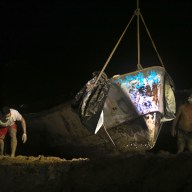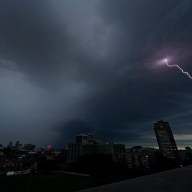MONTREAL – The Navy concluded it had an image problem while preparing for its 100th anniversary, and has decided to change that by launching public-relations exercises aimed at boosting its profile and attracting more recruits.
It’s the smallest component of the Canadian Forces, with 9,200 employees, and its leaders hope that hot-button topics such as Arctic sovereignty and high-seas piracy will help tempt more people into a maritime career.
The Navy is now keen to take its message to Canadians.
Starting this week, and through Oct. 5, the HMCS Ville de Quebec will travel from Halifax to Sarnia along the St. Lawrence Seaway and through the Great Lakes, stopping at numerous ports throughout Ontario and Quebec.
It’s about as inland as the Navy can get.
The Great Lakes Deployment has become an annual event. But it takes on some added meaning as Canada’s Navy prepares to celebrate its centennial in 2010.
With a brand new commander at its helm committed to raising the Navy’s profile, Canadians can expect to hear a lot more from the Canadian Forces underdog. Journalists are being invited to sail with the crew over the next few weeks.
“I think it’s true Canadians don’t know enough about what type of Navy they’ve got, what their Navy’s doing for them every single day,” vice-admiral Dean McFadden, who assumed command of the Navy in June, told The Canadian Press.
“We have not, as an institution, done a good enough job of explaining it.”
All of which might be surprising in a place like Canada – which has four times more coastline than any other country on Earth, spanning 243,000 kilometres of ocean shore and archipelago.
McFadden said it’s harder to tell the story of a Navy seaman.
There are no instantly recognizable images like that of an Army infantryman, watching over a vaccination program in Afghanistan with his rifle at the ready, which would instantly explain what Canada’s seamen are up to.
Yet everyday they’re patrolling the coastlines, protecting Canada’s fisheries and helping to guard against environmental violations.
“I don’t think Canadians know that – unless you’re close to where we sail the ships from,” McFadden said. “To some degree we have a problem of geography.”
The 2004 HMCS Chicoutimi submarine fire that killed a Canadian submariner and injured several others off the coast of Ireland did thrust the Navy into the spotlight, albeit in a negative way.
But the Navy has bounced back from the tragedy and worked to rebuild its image – even if it continues to be overshadowed by its Air Force and Army siblings.
The Navy does have a few things going for it as it prepares for its next 100 years.
Arctic sovereignty and high seas piracy have become hot-button topics and the 180 crew members taking part in the Great Lakes deployment hope to share their tales with the hundreds of prospective recruits, and college career counsellors, who will be invited aboard the vessel.
Ville de Quebec Cmdr. Luc Cassivi said about 60 per cent of the crew was involved in last year’s anti-piracy and humanitarian aid operations off the coast of Somalia.
“It was our first involvement with the World Food Program from a naval perspective, I believe, and it had been quite successful and very appreciated,” he said.
“The anti-piracy operation… brought to mind that there’s still things to work on in the high seas and it’s putting on the focus of a bunch of officials from a number of countries to find ways to help resolve this problem and secure our commercial lines of communication.”
While much has also been made in recent months of Canada’s efforts to replace and refurbish the Navy’s aging fleet of ships, there’s also a need for more manpower.
A big part of the Great Lakes Deployment will involve trying to recruit young people into a variety of technical fields.
“This is the first year that the Navy is being very pro-active in actually identifying desired audiences and bringing these potential recruits to the ship and putting on specialized tours,” said Lt.-Cdr. Dave King, who works as a naval recruiter.
Career counsellors along the route will be invited to sail, along with students enrolled in technical programs that qualify for CF subsidies.
Compared with the Army’s 23,500 soldiers and the Air Forces’s 13,500 airmen, the Navy is the smallest component of the Canadian Forces.
Its 2009-2010 recruiting requirement stands at nearly 1,100 for some 20 different occupations, King said. When you factor in the reserves, McFadden suggests the Navy is actually about 3,000 seamen short of an optimal force.
He said it’s not so much about growing the size of the Navy, it’s about playing catch-up. He’s confident the decline over the last five years is starting to reverse and he’s staking his reputation on it.
“I’ve been in the job a little over a month and pretty much it will be one of those things I give myself as a pretty tough score card a year from now,” he said.
“(I will ask), ‘Am I right that we’ve reversed those trends and are we starting to see the numbers increase?”‘













